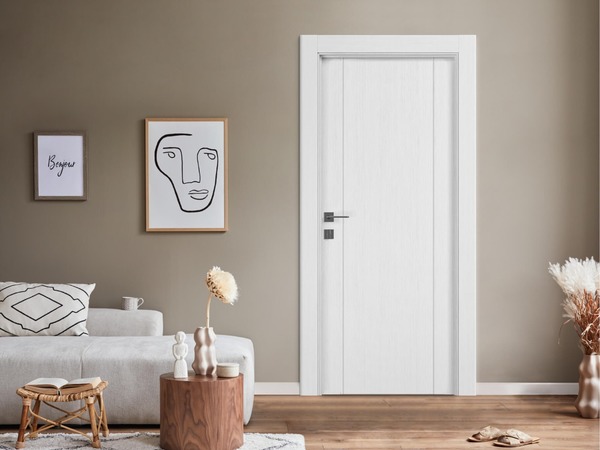
The installation of a door handle is not merely a matter of functionality; it is also a significant design element that can affect the overall impression of an interior space. Furthermore, the correct installation of a door handle ensures the safety of the home. This article will demonstrate that the installation of a door handle is a task that can be completed by anyone. The article will demonstrate how to select the most appropriate handle and install it correctly.
Prior to commencing the installation of a doorknob, it is necessary to ascertain the requisite tools. The following list outlines the tools required and their intended purpose:
- Screwdriver: A screwdriver is used to tighten and loosen screws. You need it to attach the new handle and latch.
- Tape measure: Used to make sure the new handle is installed at the right height.
- You will need a drill: to make holes for the screws or latch if the old holes are not the right size.
- New door handles: You can't install them without these.
- Screws: These secure the new handle to the door.
- Latch: This holds the door closed.
With these tools, you can easily replace your old door handle with a new one, ensuring a secure door and an updated look.
Stage one: Installing the latch
Step 1: Remove the old door hardware
Before installing new hardware, remove the old hardware. Start with the door handle and lock. Unscrew them and remove them carefully. Sometimes you need to remove the locking bar by unscrewing the fasteners and taking it off the door.
Replace the locking bar when installing a new latch. You often need to remove the old locking bar when installing a latch. This is a metal bar with a slot for the latch tongue. It is attached to the side of the door and can be round or rectangular. New latches usually come with locking strips.
Step 2: Mount the security plate on the door lock
Just choose the right plate for your lock – it can be either rectangular or round. If your latch doesn't match the shape of the hole in the door, you'll need to get a new plate. Take out the old one and put in a new one you've already bought, so that it goes with the door opening.
Make sure the plate is on the latch so it doesn't damage the inside of the door when it's closed. Rectangular plates are pretty much the industry standard, as they fit most latch models.
Step 3: Installing the latch
To get the latch in the right place on the edge of the door, it's important to make sure the side with the sloping edge is facing the door frame. If you don't do this, you might have trouble closing the door.
Step 4: Applying the latch fitting bar
If the latch doesn't fit easily, try this method. Take a piece of wood that's roughly the same width as the mechanism and place it at the end. Use a hammer to tap the block lightly to make sure the latch fits into its designated hole as far as it will go.
Step 5: Secure the latch with screws
Just use two screws for the final fix, one on top and one on the bottom of the latch. Depending on the model, just attach the right number of screws to lock the latch in place.
You don't need to buy any extra bits and bobs, like screws, to fix the latch in place. In most cases, you'll find the necessary fasteners are already included in the standard kit that comes with the main product.
Stage two: Installing the door handle
Step 1: Begin by installing one part of the handle, which has a square metal pin on the side
You'll need to thread this pin through the insides of the door locking device. Next, take the second handle part and put it on the other side of the door opening, making sure the screw holes on both parts line up. Just make sure the handles are perfectly aligned.
Step 2: If the door handles seem a bit unstable, follow these steps to level them
Grab each side of the handle with your hand and try to slide them towards each other through the hole in the door. If the handles don't connect properly and one of them seems stuck, try sliding them slightly apart. Just check that the part of the handle that doesn't have the square pin is properly mated with the part that has the rod. This will make sure the handles are secure and stable once they're installed.
Step 3: Now for the third step: install the door handle using the screws
First, check how many holes there are on the handle for screwing in with screws. Make sure the number of screws you have matches the number on the handle. Then, use a screwdriver to fasten the handle to the door by screwing it on both sides.
Usually, you'll need two screws to install a door handle – one at the top and one at the bottom.
Stage three: Final Steps and Testing
1. Fastening the screws with wood putty
In the event that the new door lock is perceived to be smaller than the existing fixing holes, it is recommended that wood putty be utilised. The aforementioned material should be utilised for filling the voids in question, which were previously occupied by the screws. Subsequently, the putty should be left to cure for a period of between one and two hours, in accordance with the instructions on the packaging.
2. The new latch strip should then be installed, ensuring that it is fitted to the door frame and the latch itself
The holes and screws provided should be used to secure the bar to the door. Should the dimensions of the latch be larger than those of the latch strip, it may be necessary to procure a more suitable component and affix it. Once the installation is complete, it is advisable to test the functionality of the door handle. This should be done by opening and closing the door several times to ensure that the latch engages smoothly with the frame and that the door is closed securely. It is necessary to ascertain whether the handle is loose. If this is the case, the screws must be tightened. Alternatively, a wooden wedge may be used to correct the screw holes.
3. In the event that the dimensions of the new door handle are smaller than those of the previous one, it is possible that there will be areas exhibiting signs of wear or unpainted surfaces
In the event that this is the case, it will be necessary to refinish the aforementioned areas. It is recommended that any scratches, chips, or uncoated areas be covered with paint or stain. Alternatively, if the door has already lost its original appearance and requires restoration, a complete repaint or polish may be considered to provide a fresh and updated look.

